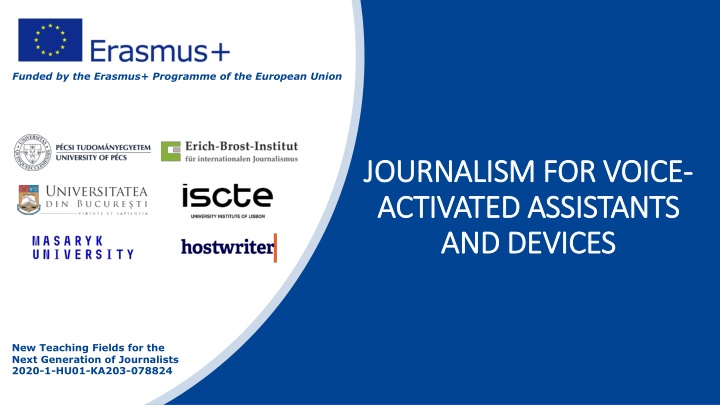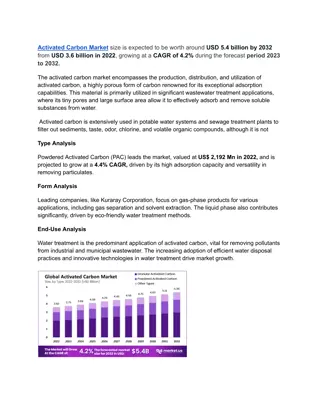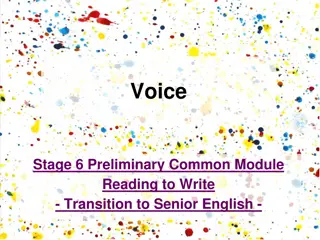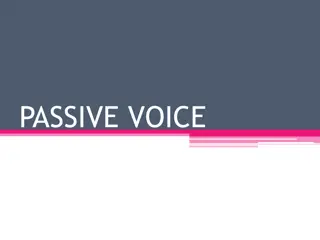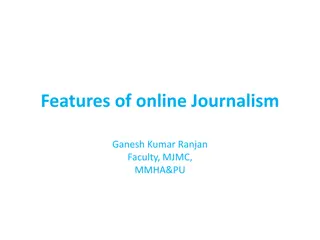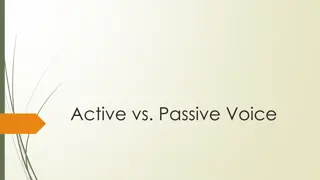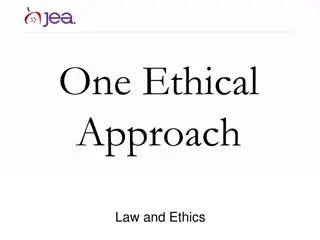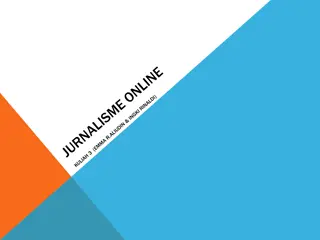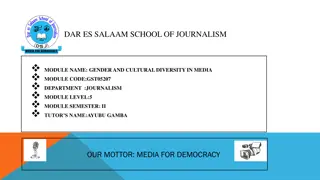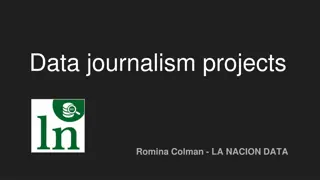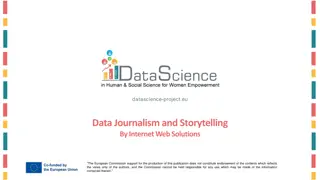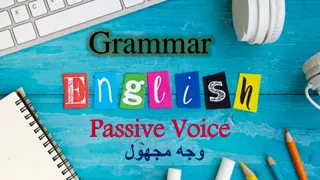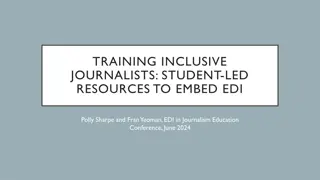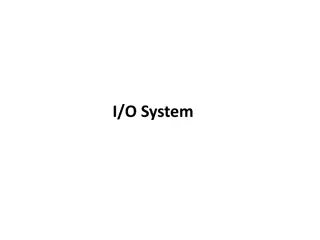Exploring the Role of Voice-Activated Devices in Journalism Education
This course funded by the Erasmus+ Programme delves into the use of voice-activated devices and assistants in media and journalism. Lessons cover history, practical applications, limitations, and the current state of these technologies. Expert authors provide insights on innovation skills, problem-solving, and translating theory into journalistic practice. Join the discussion on the present and future uses of voice-activated devices in the field of journalism.
Download Presentation

Please find below an Image/Link to download the presentation.
The content on the website is provided AS IS for your information and personal use only. It may not be sold, licensed, or shared on other websites without obtaining consent from the author.If you encounter any issues during the download, it is possible that the publisher has removed the file from their server.
You are allowed to download the files provided on this website for personal or commercial use, subject to the condition that they are used lawfully. All files are the property of their respective owners.
The content on the website is provided AS IS for your information and personal use only. It may not be sold, licensed, or shared on other websites without obtaining consent from the author.
E N D
Presentation Transcript
Funded by the Erasmus+ Programme of the European Union JOURNALISM FOR VOICE JOURNALISM FOR VOICE- - ACTIVATED ASSISTANTS ACTIVATED ASSISTANTS AND DEVICES AND DEVICES New Teaching Fields for the Next Generation of Journalists 2020-1-HU01-KA203-078824
Lesson2 - Voice-activated devices and assistants and their use in media and journalism
The Course Journalism for voice-activated assistants and devices Lesson 1 - Brief history of voice-activated devices and assistants Lesson 2 - Voice-activated devices and assistants and their use in media and journalism Lesson 3 - Languages and limitations to produce and search contents for voice-activated devices and assistants Lesson 4 - State of the art of voice-activate devices and assistants
About the authors Miguel Crespo is a journalist, editorial consultant, and MediaLab_ISCTE -University Institute of Lisbon, and OberCom Portuguese Media Observatory. Lecturer at ISCTE and European University Lisbon, and trainer at ETIC Creative School and Cenjor Portuguese Training Center. Communication Sciences and Master s in Communication, Information Technologies. Ana Pinto-Martinho is a journalist and researcher at MediaLab_ISCTE University Institute of Lisbon of ISCTE-IUL and Obercom Observatory. Lecturer where she is the executive coordinator of the post-graduation Journalism. She is currently working on her PhD, has a Master s degree in Communication, Culture and Information Technologies and a Bachelor's Degree in Communication Sciences. Wanessa Andrade is a journalist for 14 years, 10 of them for the largest communication company America, TV Globo, where she was a reporter, anchor Nominated for Documentary Emmy Awards. Trainer in communication, storytelling strategies for social media and video recording and editing techniques. Master's in Internet Studies (ISCTE-IUL). - researcher at in Latin Portuguese at Media ISCTE-IUL, and editor. and the News programme in Journalists PhD student in Culture, and
What we are going to discuss Voice-activated devices and assistants and their use in media and journalism. Discussion focused on present and future uses: Innovation skills in the field. Problem solving skills. Translate theoretical insights into journalistic practice and vice versa.
Journalism consumption In the area of journalism, publishing news bulletins, with breaking news, daily or several times a day, is the most common. Usually, even taking in account entertainment products, the most accessed content is the daily new. So, journalism also stands out among the products offered. Short newsletters with information on politics, health and daily life are also between the most accessed.
Journalism consumption So far, one format that has worked best is a newsletter, with a news summary of up to 5 minutes. This goes in line the most common uses of these equipment, usually related to functional activities, such as listening to information about the weather, traffic, general information, etc. Figure 1: Proportion that use smart speakers for any purpose (2017-20) Selected countries. Source: Reuters Institute (2020).
Journalism consumption For now, a major fact is that the smart-speakers user hardly has a casual habit, he always has a specific time for a specific purpose of content consumption. The peak consumption time is early in the morning, until 8am.
Journalism production Content curation has different approaches in newsrooms: In some cases, there is an editor: a person who stays in the newsroom and then each editorial office - with the support of developers -, develops the content. In other cases, there is a dedicated team, usually with experience in audio production, to think about product development.
Journalism production In all cases, companies agree to say that a product to be activated by a smart speaker cannot be thought of in the same way as content that will be accessed by another platform, because of the uniqueness of the devices. Generally, people who use voice interactions are more active than spectators and will not always have the support of a visual resource on a screen. On the contrary, the main resource is precisely the voice.
Journalism production Thus, the "spoken" text needs to be understandable enough for people to be able to use it without resorting to other channels. That's why it's important to think of several ways out of the box to circumvent users' multiple intentions. That s why the companies (media and/or tech) don't talk about amounts invested, but they all stress the importance of having dedicated product development teams for smart speakers.
Journalism production Some media companies decided to start restructuring, to become media tech companies. These companies assume this investment is necessary, as voice interactions via smart-speakers and smart-screens, connected cars and other devices that carry this technology, such as smartphones, headsets and smart-watches, are increasingly gaining market share. For them, it is a new communication channel that will allow to expand the points of contact with its consumers' journey.
Consumption context In context, in terms of which is the main source of information, some data for online news consumption behavior reveal: +37% use social networks as the main source of information +32% use news sites +11% use television +9% use smart speakers Note that smart speakers are already close to television and ahead of other traditional media, as newspapers (+5%) and radio (+2%), and podcasts (+4%).
Consumption context The profile of the users of smart speakers are people who are used to using the Internet on a daily basis. They are also people who have web platforms as their main source of information: +80% have social networks, news sites, the smart speakers themselves, and podcasts as their main source of information That is, the traditional media (TV, radio, and newspapers) add up to less than 20% as their main source of information.
Consumption context UK data shows that in 2020 only 5% used smart speakers to search for news (Reuters Institute, 2020) But 66% of Portuguese speaking users of smart speakers say they tried to do any news search on these devices (Andrade, 2021) This may indicate that there is a great potential of this platform for distribution of journalistic content, and in different languages Figure 2: Proportion that use each device to access news in the last week (2013-20) -UK. Source: Reuters Institute (2020).
Consumption context When questioned about the regular use of smart speakers, users say that the devices are most often used for entertainment, but the search for information comes right after, even ahead of the activation of home appliances. This reinforces the perspective that there is a great potential for the distribution of journalistic content on this platform. See chart in the next slide.
Consumption context Figure 3: Use of smart speakers (%). Source: Andrade (2021)
Consumption practices Among those who pointed out that they use the equipment to listen to news or information podcasts: 53% do it daily 27,42% do it up to 3 times a week This seems to indicate that those who use a smart speaker to listen to news do so on a regular basis. (Andrade, 2021) See chart in the next slide.
Consumption practices Figure 4. Frequency of use of the device to listen to news or information podcasts (%). Source: Andrade (2021)
Consumption practices To understand how users search for news on these devices, they where asked what they say to the smart speaker to get the news. News of day is the most common Asking for the news of a specific media is the second option (Andrade, 2021) See chart in the next slide.
Consumption practices Figure 5: Most common requests for news (%). Source: Andrade (2021)
Consumption best practices Many media companies developing contents to smart speakers fulfill these needs, offering news bulletins, especially designed for the voice- assistant devices, since users seem to want a summary of what is happening. There is also indication that people use the news function mainly in the morning.
Consumption best practices About the advantage of using these devices to search for news: most users point pointed out that "no typing, just talking" is the main advantage. The 2nd reason is the fact that "the result is faster than other search tools, such as Google". the 3rdis that "the result appears exactly what you want to hear Almost all users say that the biggest advantage is being able to do another activity while listening to the news.
Production best practices To meet the users needs: communications companies need to train the professionals already in the market universities need to prepare students to produce content to be activated by voice assistants Not only for the language, which is different from TV, print, radio or internet websites: the content must be text to be heard, and in an objective way!
Production best practices Also, implementing AI-based solutions also requires: the development of a strategic vision, economic investment, interdisciplinary team building, and the search for alliances with educational and technological organizations. The processes developed with AI should be auditable, adjustable, transparent, and traceable, and respond to ethical standards of journalism; the latter is perhaps the most critical aspect of intelligence implementation in the media industry.
Controlling questions The most common journalistic content users search for is (select the correct answer): Long format stories News bulletins Interactive content Sports results (correct answer in RED)
Controlling questions The peak consumption time is (select the correct answer): Late in the evening, after 8pm In the afternoon, before 8pm Early in the morning, until 8am In the morning, after 8am (correct answer in RED)
Controlling questions A journalistic product to be activated by a smart speaker cannot be thought of in the same way as content that will be accessed by another platform: False True (correct answer in RED)
Controlling questions Which are the sources of information, according to the online news consumption behavior (put in order, from first to last): 7 radio 2 news sites 3 television 6 podcasts 4 smart speakers 1 social networks 5 newspapers (correct answer in RED, from first to last)
Bibliography, referred works Amelia (2020), A Beginner s Guide to Conversational AI - executive summary. www.Amelia.com Andrade, W. (2021) Smart speakers and the news in Portuguese: consumption pattern and challenges for content producers. Available at http://hdl.handle.net/10071/23092 BBC News Lab (2020), Journalism https://bbcnewslabs.co.uk/news/2020/journalism-innovation- 2020s/?fbclid=IwAR0Z7vCpRDsbx78zzpyTrd_kBfxcQ-N53a200k-LB2N6Sbze-5O5YFXwVo8 Beckett, C. (2019), New powers, new responsibilities: a global survey of journalism and artificial intelligence (Polis/LSE), https://blogs.lse.ac.uk/polis/2019/11/18/new-powers-new-responsibilities/ CDEI (2019), Smart Speakers and https://assets.publishing.service.gov.uk/government/uploads/system/uploads/attachme nt_data/file/831180/Snapshot_Paper_-_Smart_Speakers_and_Voice_Assistants.pdf Chung, H., Iorga, M., Voas, J., & Lee, S. (2017), Alexa, can I trust you?, Computer, 50(9), 100-104. innovation in 2020, Available at available at Voice Assistants, Available at
Sources of Photos Illustration pictures: Articulate Content Library 360 Unsplash: All photos published on Unsplash can be used for free. You can use them for commercian and non-commercial purposes. https://unsplash.com/license Pixabay: CCO 1.0 Universal (CC0 1.0) Public Domain Dedication http://www.pixabay.com
Sources of Photos Freepik: https://www.freepik.com/ Pexels: All photos on Pexels can be used for free. https://www.pexels.com Microsoft Powerpoint Stock Photos
Where you can find us newsreel.pte.hu newsreel@pte.hu thenewsreelproject @thenewsreelproject The project was funded by the European Commission. The views expressed in this publication do not necessarily reflect those of the European Commission. @newsreelproject
